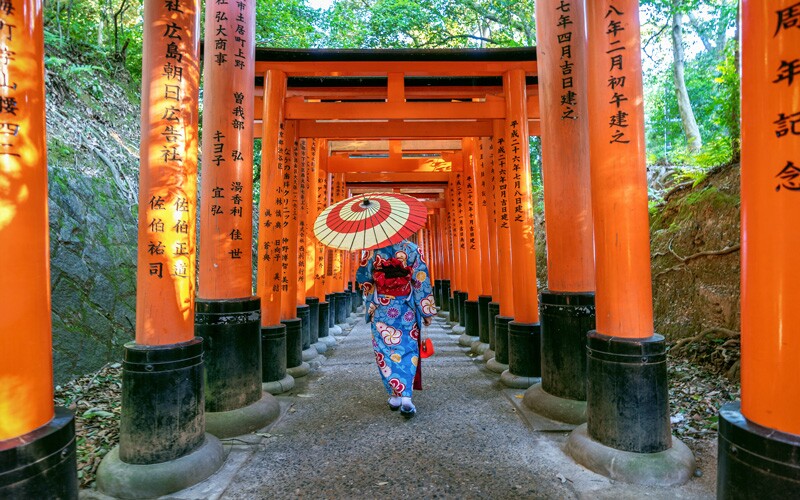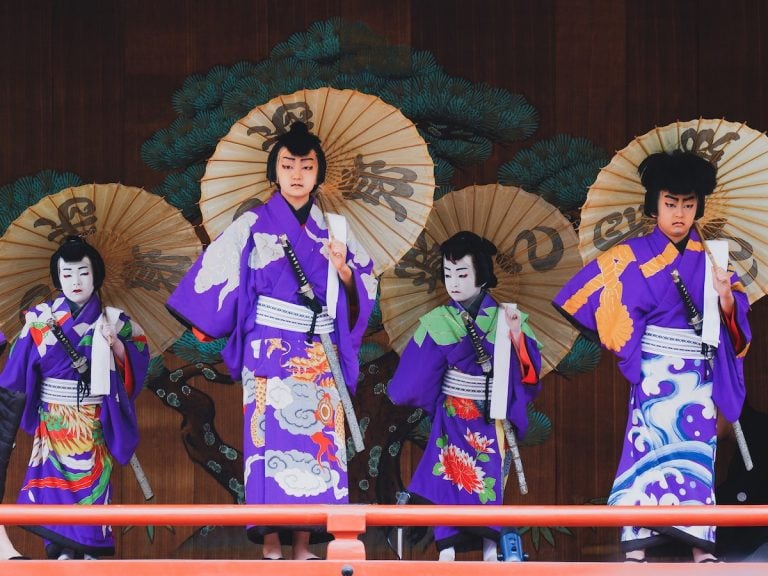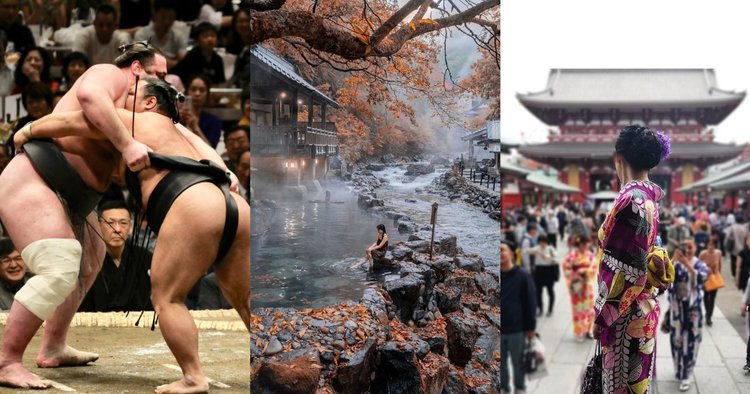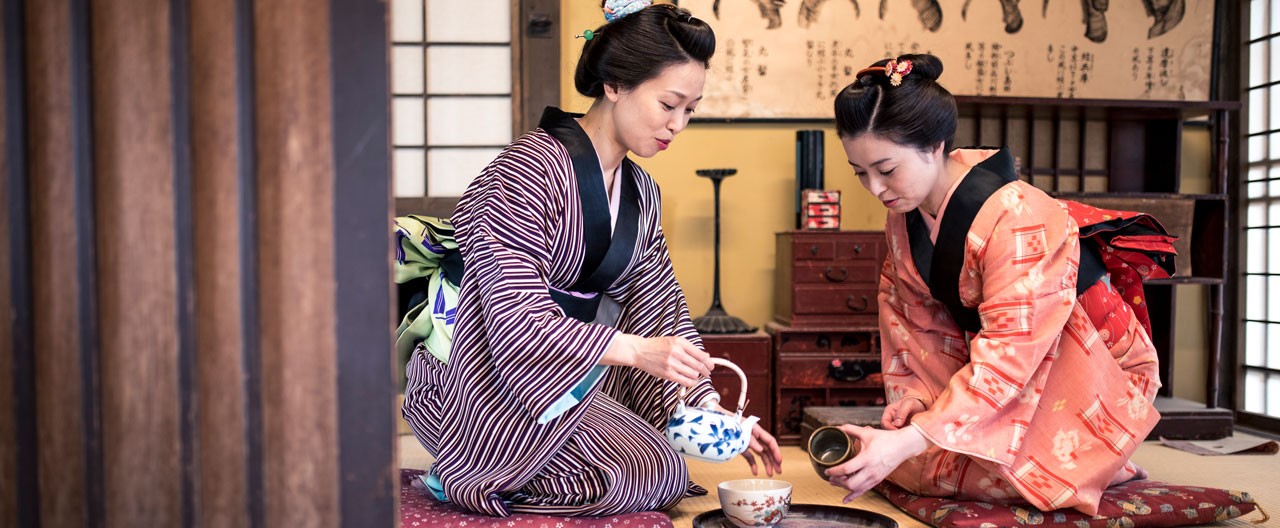Japan boasts a rich tapestry of culture that captivates the senses and invites exploration. From the exquisite flavors of traditional Japanese cuisine to the intricate art forms that define its heritage, every aspect of Japan culture reflects a deep appreciation for beauty and tradition. In this blog post, we will journey through the diverse elements of Japan, including regional culinary practices, the art of sushi making, and the significance of ancient festivals, all while celebrating the timeless customs that continue to shape modern life.
Win a Free Trip to Japan!
Experience cherry blossoms and ancient temples
Japanese Cuisine: An Overview of Traditional Dishes
Japanese cuisine offers an exquisite variety of flavors, showcasing the nation’s rich history and cultural diversity. At the heart of Japan culture lies the philosophy of balance and harmony, evident in its culinary practices. Here are some key traditional dishes that embody this concept:
- Sushi: This iconic dish consists of vinegared rice combined with seafood, vegetables, or sometimes tropical fruits. Sushi has evolved into various forms, such as Nigiri and Maki rolls.
- Ramen: A hearty noodle soup, ramen comes with different broths (shoyu, miso, tonkotsu) and toppings (chashu, egg, green onions). Each region boasts its unique ramen style, reflecting local flavors.
- Tempura: A dish featuring lightly battered and fried vegetables or seafood. This technique originated from Portuguese missionaries in the 16th century and has become a staple in Japan culture.
- Kaiseki: A traditional multi-course meal that highlights seasonality and the art of presentation. Kaiseki is an intricate culinary experience that showcases the chef’s skill and creativity.
- Okonomiyaki: Often dubbed "Japanese pizza," this savory pancake is filled with various ingredients, from cabbage to seafood, catering to regional tastes.
Understanding these traditional dishes offers a glimpse into the heart of Japan culture, illustrating how food serves as a celebration of nature and community. By embracing Japan culture through its cuisine, we appreciate the intricate relationship between culinary art and cultural heritage.

Regional Variations in Japanese Culinary Practices
Japan boasts a rich tapestry of regional culinary practices, each influenced by the local ingredients, climate, and traditions. Consequently, these variations contribute significantly to the overall experience of Japan culture. Here are some key regional highlights:
Hokkaido
- Famous for: Fresh seafood, particularly crab and salmon.
- Special dish: Jukkoku Goya, a hearty soup featuring local vegetables.
Kanto (Tokyo Area)
- Famous for: Soy sauce-based dishes and sushi.
- Special dish: Edomae-zushi, which centers on fresh fish served atop vinegared rice.
Kansai (Osaka and Kyoto)
- Famous for: Savory pancakes and grilled dishes.
- Special dish: Okonomiyaki, known as a Japanese savory pancake.
Kyushu
- Famous for: Rich flavors and hearty ramen.
- Special dish: Tonkotsu ramen, famous for its rich pork broth.
Comparison Table of Regional Specialties
| Region | Signature Dishes | Key Ingredients |
|---|---|---|
| Hokkaido | Jukkoku Goya | Seasonal vegetables, crab |
| Kanto | Edomae-zushi | Fresh fish, vinegared rice |
| Kansai | Okonomiyaki | Flour, cabbage, eggs |
| Kyushu | Tonkotsu ramen | Pork bones, wheat noodles |
Exploring these regional variations enriches the understanding of Japan culture, revealing how geography shapes culinary styles. From the fresh seafood of Hokkaido to the savory delights of Kansai, each region offers a unique glimpse into Japan’s diverse food culture.
The Art of Sushi Making: Techniques and Traditions
Sushi has transcended its origins to become a global culinary phenomenon, yet its roots are deeply embedded in Japan culture. Understanding the art of sushi making reveals the intricate techniques and traditions that chefs meticulously uphold.
Key Techniques in Sushi Making
- Rice Preparation: Sushi rice, or shari, is prepared using high-quality short-grain rice, seasoned with vinegar, sugar, and salt. This process is crucial as the rice is the foundation of sushi.
- Fish Selection: Chefs choose fresh, high-quality fish to ensure the best flavor. Popular choices include tuna, salmon, and eel.
- Knife Skills: Precision slicing enhances both the appearance and taste of sushi. The chef must master various cutting techniques to achieve optimal texture.
- Rolling Techniques: From makizushi (rolled sushi) to nigiri (hand-formed sushi), each type requires specific skills and techniques.
- Presentation: Aesthetically pleasing presentation is essential, reflecting the harmony and beauty of Japan culture.
Traditional Practices
- Omakase: This dining experience allows chefs to create a bespoke tasting menu, showcasing their craftsmanship and the season’s best ingredients.
- Cultural Significance: Sushi making embodies respect for nature and culture—every element from rice to fish symbolizes a connection to the environment.
Incorporating these techniques and traditions, sushi stands as a true hallmark of Japan culture, where artistry meets culinary excellence.
Understanding Japanese Tea Ceremony: A Cultural Ritual
The Japanese tea ceremony, known as chanoyu or sado, embodies the essence of Japan culture through a harmonious blend of philosophy, aesthetics, and ritual. This ceremonial practice transcends mere tea drinking; it is an intricate tradition that emphasizes mindfulness, respect, and the beauty of simplicity.
Key Elements of the Tea Ceremony:
- Historical Roots: Originating in the 12th century, the tea ceremony evolved over centuries, influenced by Zen Buddhism. It reflects the ideals of tranquility and contemplation.
-
Utensils Used:
- Chawan: Tea bowl
- Chasen: Bamboo whisk
- Chashaku: Bamboo scoop
- Kama: Kettle
Ritual Process:
- Preparation: The host meticulously cleans the utensils, symbolizing purification.
- Serving: Matcha (powdered green tea) is whisked and served with traditional sweets, highlighting seasonal themes.
- Consumption: Guests appreciate the artful presentation and savor the flavor mindfully.
Cultural Significance:
- Social Harmony: The tea ceremony fosters connections and mutual respect among participants.
- Aesthetic Appreciation: Attention to detail and beauty, from the room decor to utensils, showcases the essence of Japan culture.
Through these practices, the Japanese tea ceremony preserves ancient traditions while continuing to influence modern cultural expressions. Engaging in this ritual not only provides insight into the significance of tea in Japan culture but also fosters a deeper appreciation for mindfulness in everyday life.

The Role of Kimono in Japanese Culture
The kimono serves as a profound symbol of Japan culture, reflecting the nation’s rich history and aesthetic values. This traditional garment transcends mere clothing; it embodies the principles of beauty, elegance, and artistry inherent in Japanese society.
Key Characteristics of Kimono:
- Fabric: Kimono typically features silk or cotton, adorned with intricate patterns and dyes.
- Design: The designs often convey messages, including seasonal themes or familial ties.
- Color: Different colors signify occasions—such as bright hues for celebrations and subdued tones for mourning.
Cultural Significance:
- Ceremonial Use: Kimonos are essential in rituals such as weddings, tea ceremonies, and festivals, marking life’s pivotal moments.
- Generational Heritage: Kimonos pass through generations, with family members valuing their rich stories and emotional connections.
- Fashion Evolution: Although modern fashion trends have influenced wear, kimonos maintain their place in contemporary celebrations, demonstrating the adaptability of Japan culture.
Comparison of Kimono Styles:
| Style | Description | Occasion |
|---|---|---|
| Furisode | A long-sleeved kimono worn by young women | Coming-of-age ceremonies |
| Tomesode | A formal kimono with shorter sleeves | Weddings and formal events |
| Yukata | A casual summer kimono, often made of cotton | Summer festivals and leisure |
The kimono, thus, plays a vital role in Japan culture, acting as a bridge between history and modernity, showcasing artistry, tradition, and identity.
Exploring Japanese Calligraphy as an Art Form
Japanese calligraphy, or shodō, transcends mere writing; it embodies the spirit and philosophy of Japan culture. This art form has deep historical roots, dating back to ancient times, and it continues to thrive today. Here are some key aspects that highlight its significance:
- Expressive Brushwork: Calligraphy utilizes various brush strokes, with each movement representing emotion and intent. The result is not just words, but a beautiful visual expression of the artist’s feelings.
-
Materials: Traditional calligraphy employs unique materials including:
- Brush: Made from animal hair, allowing for precise strokes.
- Ink: Typically grounded from ink sticks, offering a rich texture.
- Paper: Washi, a type of Japanese paper, enhances the overall appearance and flow.
-
Styles: Different calligraphy styles embody distinct characteristics:
- Kaisho (block style): Clear and easy to read.
- Gyōsho (semi-cursive): A more fluid form, balancing speed and elegance.
- Sōsho (cursive): Highly stylized, often abstract yet rich in artistic expression.
- Cultural Significance: Calligraphy reflects the harmony between art and intellect, embodying concepts of Zen Buddhism prevalent in Japan culture. Each piece tells a story, inviting contemplation of its themes.
In summary, Japanese calligraphy is more than an art form; it’s a cultural experience that preserves the essence of Japan culture through its intricate techniques and philosophical depth.
Traditional Japanese Festivals: An Insight into Celebrations
Japan Culture thrives on its vibrant festivals, known as matsuri. These events, rooted in tradition, offer a glimpse into the rich heritage and communal spirit of the Japanese people. Festivals celebrate various aspects of life, from agricultural cycles to spiritual beliefs. Here’s an overview of what characterizes these important cultural events:
- Purpose: Traditional festivals often honor deities, show gratitude for harvests, or celebrate the changing seasons.
- Activities: Participants engage in lively parades, traditional dance, and music performances. Food stalls often line the streets, offering local delicacies that reflect regional variations in Japan Culture.
- Attire: Many attendees wear traditional clothing, such as yukata or kimono, embracing the heritage that defines these celebrations.
| Festival | Location | Time of Year | Key Features |
|---|---|---|---|
| Gion Matsuri | Kyoto | July | Grand parade, floats (yamaboko) |
| Nebuta Matsuri | Aomori | August | Colorful lantern floats |
| Tanabata Matsuri | Nationwide | July (early) | Star festival, writing wishes on tanzaku |
| Kinosaki Onsen Winter | Kinosaki | January-February | Snow lanterns, hot springs experience |
These festivals showcase Japan Culture’s deep connection to nature, community, and spirituality. By participating in or observing these events, one gains valuable insights into Japan’s values and the continuity of its cultural practices.

Seasonal Festivals: Celebrating Nature and Change
Seasonal festivals play a vital role in Japan culture, allowing communities to celebrate the changing seasons while paying homage to nature. These festivities often tie deeply into agricultural traditions, reflecting ancient customs that honor the earth and its bounty. Here are some notable seasonal festivals that showcase this connection:
Key Seasonal Festivals:
-
Hanami (Cherry Blossom Viewing) – Spring
- When: March to April
- Highlights: Picnicking under blooming sakura trees, celebrating the ephemeral beauty of flowers.
-
Tanabata (Star Festival) – Summer
- When: July 7
- Highlights: Writing wishes on colorful strips of paper and hanging them on bamboo branches under the stars.
-
Momijigari (Maple Viewing) – Autumn
- When: October to November
- Highlights: Enjoying the vibrant fall foliage at parks and temples, often accompanied by special foods.
-
Oshogatsu (New Year) – Winter
- When: January 1-3
- Highlights: Traditional family gatherings, special meals like mochi, and rituals to welcome good fortune.
These festivals not only celebrate seasonal changes but also foster a sense of community and shared experience. Through engaging in these customs, individuals pass down important aspects of Japan culture to future generations, ensuring the preservation of these beautiful traditions.
Modern Influences on Japanese Culture and Arts
The landscape of Japan Culture continuously evolves, blending age-old traditions with contemporary influences. As globalization permeates various aspects of life, modern trends leave a significant footprint on traditional practices, especially in arts and culture. Here are some pivotal modern influences shaping Japan today:
- Pop Culture: Japanese anime, manga, and J-pop have transcended borders, influencing global entertainment and fashion. This phenomenon revitalizes traditional art forms, inspiring new genres and styles.
- Technology: The infusion of technology in art creation has revolutionized practices. Digital art and interactive installations attract younger generations, while traditional artists adopt tech to enhance their work.
- Fashion Trends: Modern fashion draws inspiration from traditional attire, merging the elegance of kimono with contemporary styles. Designers often showcase unique blends that redefine Japanese fashion on global runways.
- Culinary Innovations: While traditional dishes remain cherished, fusion cuisine has emerged, adapting classic flavors to suit modern palates. Chefs experiment with techniques and ingredients, resulting in a culinary renaissance.
| Aspect | Traditional Influence | Modern Influence |
|---|---|---|
| Art | Ukiyo-e (woodblock prints) | Digital art and mixed media |
| Fashion | Kimono and Yukata | Streetwear and fusion styles |
| Cuisine | Sushi and Ramen | Fusion cuisine and world flavors |
These modern influences not only celebrate the richness of Japan Culture but also ensure its vitality, making it relevant for future generations. Embracing both tradition and modernity creates a more dynamic cultural landscape, enriching Japan’s heritage.
Conclusion: The Importance of Preserving Cultural Heritage
Preserving cultural heritage is essential in maintaining the rich tapestry that defines Japan Culture. As globalization accelerates, traditional practices and customs risk being overshadowed by modern influences. Therefore, recognizing the significance of cultural preservation becomes increasingly crucial.
Key Reasons for Preservation:
- Identity: Cultural heritage strengthens national identity. For example, traditional festivals foster community spirit and enhance a shared sense of belonging among Japanese people.
- Education: Preserving Japan’s arts, cuisine, and rituals provides a valuable educational resource for future generations. Understanding the historical context behind sushi making or the tea ceremony enriches knowledge of broader societal values.
- Tourism: Many travelers explore Japan to experience its unique cultural heritage. Encouraging cultural preservation can boost local economies and promote sustainable tourism.
- Innovation: Integrating traditional arts with modern techniques stimulates creativity. Contemporary artists often draw inspiration from Japan Culture, evolving it while respecting its roots.
Conclusion
In summary, embracing and preserving the richness of Japan Culture ensures that future generations can connect with their past. This commitment not only safeguards unique traditions but also enables a dynamic engagement with heritage, allowing it to thrive in a modern context. As individuals, communities, and nations come together to celebrate their cultural legacies, they reinforce the values that foster unity and diversity alike.
Frequently Asked Questions
What are some traditional Japanese dishes that I must try when experiencing Japan’s cuisine?
When exploring Japanese cuisine, there are several traditional dishes that are a must-try. Sushi, which consists of vinegared rice paired with various ingredients like raw fish, is globally renowned. Ramen, a hearty noodle soup, comes in numerous regional variations, each with distinct flavors. Tempura, featuring battered and deep-fried seafood and vegetables, offers a unique texture and taste. Additionally, try Odori Ebi, where shrimp is served raw and dances on the plate, providing an unforgettable dining experience.
How do Japanese festivals reflect the culture of Japan?
Japanese festivals, or ‘matsuri’, are vibrant celebrations that highlight regional traditions, religious beliefs, and community spirit. They often feature parades, traditional music, dance, and local delicacies, immersing participants in Japan’s rich cultural landscape. Festivals are usually tied to the seasons or historical events, like the cherry blossom festivals in spring or Gion Matsuri in Kyoto during summer. These festivities not only showcase artistic expression through floats and costumes but also foster a sense of belonging among participants.
What role does art play in Japanese culture, and what are some notable art forms?
Art holds a significant place in Japanese culture, deeply interwoven with its history and traditions. Notable art forms include traditional painting styles such as Ukiyo-e, which showcases landscapes, kabuki actors, and beautiful women through intricate woodblock printing. Additionally, ceramics and pottery, such as those from the renowned towns of Arita and Mashiko, embody Japan’s aesthetic values. Calligraphy, a practiced form of brushwork, demonstrates discipline and spiritual expression, while contemporary art integrates modern techniques and ideas, continuing Japan’s artistic evolution.
What are the key components of a traditional tea ceremony in Japan?
A traditional Japanese tea ceremony, known as ‘chanoyu’, is a meticulous ritual that embodies harmony, respect, purity, and tranquility. Key components include the preparation and presentation of matcha, a powdered green tea, served in a serene setting decorated with seasonal flowers and art. The ceremony often takes place in a tea room, emphasizing simplicity and naturalness with tatami flooring and minimalistic decor. Participants engage in mindfulness throughout the ceremony, appreciating the serenity of the moment, the beauty of the utensils, and the flavors of the tea.
How can I immerse myself in Japanese culture while visiting Japan?
Immersing yourself in Japanese culture during your visit involves engaging with locals, participating in traditional activities, and experiencing local customs. Attend a tea ceremony or kimono-wearing experience to appreciate Japan’s historic practices firsthand. Exploring local markets and trying street food will introduce you to regional flavors. Additionally, visiting shrines and temples allows you to observe Japan’s spiritual side. Lastly, attending a festival during your trip will provide an immersive experience filled with music, dance, and traditional crafts that encapsulate the essence of Japanese culture.
